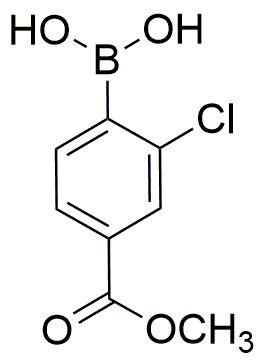2-Chloro-4-(methoxycarbonyl)phenylboronic acid is widely utilized in research focused on:
- Pharmaceutical Development: This compound is crucial in synthesizing various pharmaceuticals, particularly in creating targeted therapies for cancer treatment. Its boronic acid functionality allows for the formation of stable complexes with biomolecules.
- Organic Synthesis: It serves as an important building block in organic synthesis, facilitating the creation of complex organic molecules through Suzuki coupling reactions, which are essential in developing new materials and drugs.
- Material Science: The compound is used in the production of advanced materials, such as polymers and nanomaterials, enhancing properties like conductivity and strength, which are vital in electronics and construction.
- Agricultural Chemistry: It finds applications in developing agrochemicals, contributing to the design of herbicides and pesticides that are more effective and environmentally friendly, thus supporting sustainable agriculture.
- Bioconjugation: This chemical is utilized in bioconjugation processes, linking biomolecules for diagnostics and therapeutic applications, providing a means to improve the specificity and efficacy of treatments.
General Information
Properties
Safety and Regulations
Applications
2-Chloro-4-(methoxycarbonyl)phenylboronic acid is widely utilized in research focused on:
- Pharmaceutical Development: This compound is crucial in synthesizing various pharmaceuticals, particularly in creating targeted therapies for cancer treatment. Its boronic acid functionality allows for the formation of stable complexes with biomolecules.
- Organic Synthesis: It serves as an important building block in organic synthesis, facilitating the creation of complex organic molecules through Suzuki coupling reactions, which are essential in developing new materials and drugs.
- Material Science: The compound is used in the production of advanced materials, such as polymers and nanomaterials, enhancing properties like conductivity and strength, which are vital in electronics and construction.
- Agricultural Chemistry: It finds applications in developing agrochemicals, contributing to the design of herbicides and pesticides that are more effective and environmentally friendly, thus supporting sustainable agriculture.
- Bioconjugation: This chemical is utilized in bioconjugation processes, linking biomolecules for diagnostics and therapeutic applications, providing a means to improve the specificity and efficacy of treatments.
Documents
Safety Data Sheets (SDS)
The SDS provides comprehensive safety information on handling, storage, and disposal of the product.
Product Specification (PS)
The PS provides a comprehensive breakdown of the product’s properties, including chemical composition, physical state, purity, and storage requirements. It also details acceptable quality ranges and the product's intended applications.
Certificates of Analysis (COA)
Search for Certificates of Analysis (COA) by entering the products Lot Number. Lot and Batch Numbers can be found on a product’s label following the words ‘Lot’ or ‘Batch’.
*Catalog Number
*Lot Number
Certificates Of Origin (COO)
This COO confirms the country where the product was manufactured, and also details the materials and components used in it and whether it is derived from natural, synthetic, or other specific sources. This certificate may be required for customs, trade, and regulatory compliance.
*Catalog Number
*Lot Number
Safety Data Sheets (SDS)
The SDS provides comprehensive safety information on handling, storage, and disposal of the product.
DownloadProduct Specification (PS)
The PS provides a comprehensive breakdown of the product’s properties, including chemical composition, physical state, purity, and storage requirements. It also details acceptable quality ranges and the product's intended applications.
DownloadCertificates of Analysis (COA)
Search for Certificates of Analysis (COA) by entering the products Lot Number. Lot and Batch Numbers can be found on a product’s label following the words ‘Lot’ or ‘Batch’.
*Catalog Number
*Lot Number
Certificates Of Origin (COO)
This COO confirms the country where the product was manufactured, and also details the materials and components used in it and whether it is derived from natural, synthetic, or other specific sources. This certificate may be required for customs, trade, and regulatory compliance.


